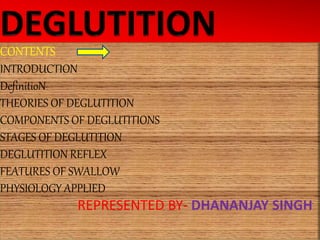
Deglutition or Swallowing
- 1. CONTENTS INTRODUCTION DefinitioN THEORIES OF DEGLUTITION COMPONENTS OF DEGLUTITIONS STAGES OF DEGLUTITION DEGLUTITION REFLEX FEATURES OF SWALLOW PHYSIOLOGY APPLIED REPRESENTED BY- DHANANJAY SINGH
- 2. INTRODUCTION:- * Deglutition or swallowing is the process by which food moves from mouth into stomach *Swallowing consist of voluntary, involuntary and reflex muscular activity. *Over a period of 24 hours swallowing occurs approximately 1000 times; which is highest while eating. *Deglutition involves co-ordinate activity of muscles of oral cavity, pharynx, larynx and esophagus
- 3. DEFINITION *Complex series of voluntary and involuntary neuromuscular contraction proceeding from the mouth to stomach and is commonly divided in to oropharyngeal & esophageal stage.
- 4. THEORIES OF DEGLUTITION 1.Theory of oral expulsion:- *This theory state that, the oral expulsion arising from contraction of tongue & mylohyoid throws bolus into the stomach.
- 5. 2.Theory of integral function:- *this theory is based on myometric and electromyographic studies & considers the act of swallowing as a dynamic process. *it is most accepted theory.
- 6. COMPONENTS OF DEGLUTITION:- *Deglutition has 3 components 1.Passage of bolus from oral cavity to stomach. 2.Protection of airway. 3.Inhibition of air entry into the stomach.
- 8. STAGES OF DEGLUTITION A.Preparatory stage B.Oral stage C.Pharyngeal stage D.Esophageal stage
- 9. ORAL STAGE * This stage food moves from mouth to pharynx *This stage of deglutition is a voluntary stage. *Bolus is placed over posterodorsal surface of the tongue . it is called preparatory position.
- 10. * Anterior part of tongue is retract and depressed. *Posterior part of tongue is elevated and retracted against the hard palate. This pushes the bolus backward into the pharynx. *During this phase, airway is open and breathing continues normally. *The oral phase of deglutition takes around 0.5 seconds.
- 11. PHARYNGEAL STAGE *It is a involuntary stage. *This stage food moves from pharynx to esophagus. *The bolus is transported from the oropharynx into esophagus by a peristaltic wave caused by contraction of the pharyngeal constrictor muscle. *Pharynx is a common passage for food and air. it divide into larynx and esophagus. *The pharyngeal phase of deglutition takes around 0.7 seconds.
- 12. *Pharynx communicates with mouth, nose, larynx and esophagus, during this stage of deglutition. *the pharyngeal phase tongue makes a rapid piston- like movement to propel the bolus through oropharynx to hypopharynx. *The glosso-pharyngeal nerve(IX) and the pharyngeal branches of the vagus (x) innervate the pharynx and larynx, and co-ordinate into swallowing centre in the brain stem.
- 14. *This stage is Involuntary stage. *In this stage food moves from esophagus to stomach. *Esophagus forms the passage for movement of bolus from pharynx to the stomach. *this phase is somewhat longer, liquids take 3 seconds whereas solid take 9 seconds. ESOPHAGEAL STAGE
- 15. *Movements of esophagus are specifically organized for this function and the movements are called peristaltic waves. *Peristalsis means a wave of contraction, followed by the wave of relaxation of muscle fibers of GIT.
- 17. *When bolus reaches the esophagus, the peristaltic wave are initiated. *usually two types of peristaltic contraction are produced in esophagus:- 1.Primary peristaltic contraction. 2.Secondary peristaltic contraction.
- 18. *The distal 2-5mm is the lower esophageal sphincter. *when bolus enters this part of esophagus, the sphincter relaxes and the contents enter into stomach. *later this sphincter contract to prevent movement of food back to esophagus.
- 19. DEGLUTITION REFLEX *Though the beginning of swallowing is a voluntary act, later it becomes involuntary and is carried out by a reflex action called deglutition reflex. *It occurs during the pharyngeal and esophageal stages.
- 20. FEATURES OF INFANTILE SWALLOW *mandible is stabilized by both tongue and facial muscles which are supplied by the 7th cranial nerve. *Because of anatomic relationship of new born pharynx and larynx, infants can swallow without interruption of breathing.
- 21. FEATURES OF ADULT SWALLOW:- *Mandible is stablized by occluding teeth and masticatory muscles which are supplied by the 5th cranial nerve. *temporary arrest of respiration is observed during swallowing.
- 22. APPLIED PHYSIOLOGY 1.DYSPHAGIA:- *Difficulty in swallowing. TYPES- 1.Oropharygeal dysphagia 2.Esophageal dysphagia Causes- *Decreased movement of esophagus due to neurological disorder such as parkinsonism. *Muscular disorders leading to difficulty in swallowing.
- 23. 2.DEGLUTITION APNEA:- *Apnea refers to temporary arrest of breathing. *Deglutition apnea or swallowing apnea is the arrest of breathing during deglutition.
